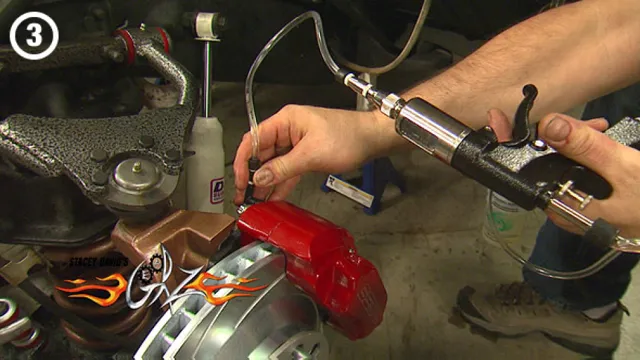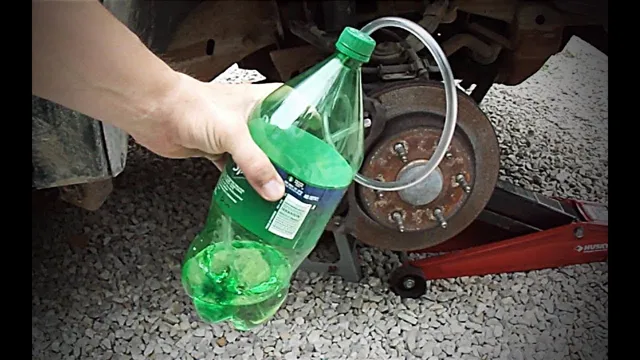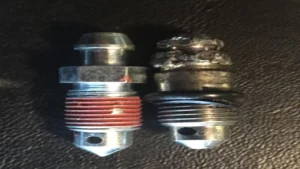Bleeding the brakes of your car can seem like a daunting task, and if you’re not careful, air can be introduced into the hydraulic system, leading to spongy brakes and a potentially dangerous situation. That’s where a self brake bleeder comes in. Using a self-brake bleeder can make bleeding your brakes a lot easier, taking less time and requiring less effort.
In this blog, we’ll explore how to use a self-brake bleeder, so you can have peace of mind and confidence when it comes to keeping your car’s brakes in top shape. So, buckle up and let’s get started!
What is a Self Brake Bleeder?
A self brake bleeder is a tool used to help remove air from a car’s brake system. It’s a great tool for DIY mechanics and professionals alike, as it allows for quick and easy removal of trapped air in the brake lines. Many self brake bleeders work by using a vacuum pump to pull the excess air out of the lines, which helps ensure that the brakes function properly.
To use a self brake bleeder, first locate the brake fluid reservoir and remove the cap. Then, attach the self brake bleeder to the brake bleeder valve and turn on the vacuum pump. As the pump starts to work, any air in the system should get pulled out, leaving behind clean, fresh brake fluid.
After completing the process, tighten up the brake bleeder valve and top off your brake fluid reservoir. Overall, using a self brake bleeder can save time and ensure the safety of the driver and passengers on the road.
Description of Tool and Benefits
A self brake bleeder is a tool used to remove air from a hydraulic brake system, ensuring that it functions properly. It is an essential tool for those who want to maintain their vehicle’s brake system, as air in the brake lines can cause the brakes to feel soft or spongy, adding friction and reducing their effectiveness. A self brake bleeder helps to fix this issue by forcing brake fluid through the system, pushing out any trapped air bubbles.
This tool is particularly useful for those who work on their cars at home, as bleeding brake lines can be a daunting and somewhat messy task. The benefit of using a self brake bleeder is that it makes it easier to bleed brakes without needing assistance from another person, making the process quicker and more efficient. It is also more affordable than taking your car to a mechanic for routine maintenance.
By using a self brake bleeder, you can save money and be confident that your brakes are in good working condition, ensuring a safer driving experience.

Preparation
If you want to learn how to use a self brake bleeder properly, then you need to begin by preparing your vehicle and surrounding area. Start by parking on a flat surface and putting on your safety gear such as goggles and gloves to avoid any potential oil spills. Then, gather all the necessary tools like the brake bleeder kit, brake fluid, and a wrench set.
It’s best to consult your vehicle’s manual for specific requirements, but most self brake bleeders require that you first bleed the brake furthest from the master cylinder. After that, work your way inward while keeping an eye on the reservoir to ensure it doesn’t run dry. One final thing to keep in mind is that air bubbles can create issues, so be sure to remove any trapped air from the system.
Overall, using a self brake bleeder is a straightforward process that can save time and money on costly repairs if done correctly.
Gather Necessary Materials
Before starting any project, gathering the necessary materials is key. This can save time, money, and minimize frustration. Depending on the task, materials may vary, but it’s important to have a clear understanding of what’s needed.
For example, if planning a DIY home renovation, the necessary materials may include paint, brushes, rollers, sandpaper, and drop cloths. It’s also important to consider the quality of materials to ensure the finished product looks great and has longevity. Cheap materials may seem like a bargain, but they can often result in a poor outcome.
Consider investing in better quality materials that will last longer and be more durable in the long run. By taking the time to gather all necessary materials before starting a project, you will be setting yourself up for a successful outcome.
Park on Level Surface
When it comes to parking your car, one of the most important things you can do is to find a level surface. Parking on a slope or incline can cause all sorts of problems for your vehicle and can even be dangerous. Before you park, take the time to look for a surface that is as flat and level as possible.
Not only will this help to keep your car safe and secure, but it will also make it easier for you to get in and out of your vehicle. Don’t be fooled by the convenience of a slightly sloping spot – always look for a level surface to park on, and your car will thank you for it in the long run. Remember, safety should always come first, so take the time to find the perfect spot for your car to rest.
Installation
If you’re wondering how to use a self brake bleeder, the installation process is actually quite simple. The first step is to locate the bleeder screw on the brake caliper or wheel cylinder. Then, attach the brake bleeder to the screw and connect the hose to a catch bottle.
Make sure the catch bottle is positioned below the brake bleeder screw to prevent air from re-entering the brake system. Once everything is in place, open the bleeder screw and pump the brake pedal until the brake fluid flows out clear and free from bubbles. Finally, close the bleeder screw and remove the self brake bleeder.
It’s important to note that this process should be repeated for each brake caliper or wheel cylinder to ensure all air is removed from the system. Overall, using a self brake bleeder is a great way to quickly and easily perform a brake system flush or replace individual components without the need for a second person to assist in the bleeding process.
Attach the Bleeder to Brake Caliper
If you’re working on a brake job or replacing your brake calipers, it’s essential to know how to attach the bleeder to the brake caliper. First things first, locate your brake caliper and identify the bleeder valve. The bleeder valve is typically on the top of the caliper, but this can vary by make and model.
Once you find it, clean the bleeder valve, and the area around it, with a clean rag or cloth. Doing this will remove any dirt or debris and make it easier to attach the bleeder. With the bleeder valve clean, take your bleeder and thread it into the valve by hand.
Make sure to not over-tighten the bleeder as you could risk damaging the valve or caliper. Once threaded in, use a wrench to snug it up. Be sure to use the correct size wrench, as using the wrong size can round off the valve, making it difficult to remove if necessary.
With the bleeder attached to the caliper, you’re now ready to start the bleeding process and ensure your brakes are working correctly. Remember that if you’re unsure about how to attach the bleeder, consult your car’s manual or speak with a trusted mechanic for guidance.
Pressurize the System
When it comes to installing a new system, one essential step is pressurizing it. This involves adding pressure to the pipes so that water can be distributed throughout the system efficiently. Without proper pressurization, the system may experience low water pressure, leaks or even burst pipes.
To pressurize the system, start by closing all the valves that lead into the system and cleaning out any debris or sediment that may be present. Next, attach the pressure gauge to the pressure release valve and slowly fill up the system with water. Watch the gauge closely as the pressure increases, and ensure it stays within the required range.
Once the system is fully pressurized, check for any leaks or weak spots in the pipes that may need to be addressed before turning the system on. Proper pressurization is crucial to the longevity and efficiency of your plumbing system, so be sure to take the time to get it right.
Bleeding the Brakes
Bleeding the brakes is an essential step in maintaining your vehicle’s performance and safety. Fortunately, with the right tools, such as a self brake bleeder, the process can be made relatively simple. To begin with, it’s important to identify the bleeder valve, which is usually found on the caliper or wheel cylinder.
Once you’ve located it, attach the bleeder kit and begin pumping the brake pedal until the fluid begins to flow out of the valve. Be sure to continuously check the brake fluid level while bleeding, as it can quickly run low. Repeat this process for each wheel until the brake fluid runs clear and free of air bubbles.
By using a self brake bleeder, you can easily and effectively bleed your brakes without the need for expensive equipment or professional assistance.
Locate Bleed Valve
When performing brake maintenance or repairs, you may need to bleed the brakes to remove any air from the system. To do this, you will need to locate the bleed valve – typically found on the caliper or wheel cylinder – and open it while someone else pumps the brakes. This allows the air to escape from the system and ensures that the brakes work as they should.
Bleeding the brakes is an important step that should not be overlooked, as air in the system can cause the brakes to feel spongy or unresponsive, making it difficult to slow down or stop when needed. So, the next time you’re working on your brakes, remember to locate the bleed valve and bleed the system to ensure optimal brake performance.
Open Valve and Begin Bleeding
Bleeding the brakes is an important maintenance task that should be performed regularly to ensure the safety of your vehicle and its occupants. The process of bleeding the brakes involves removing any air bubbles that may have entered the brake system and replacing them with fresh brake fluid. To begin, locate the brake bleeder valve on each brake caliper, and attach a clear hose to it.
Then, open the valve and begin pumping the brake pedal until clean brake fluid comes out of the hose. Remember to keep an eye on the fluid level in the brake reservoir and top it up as needed to prevent air from entering the system. Bleeding the brakes may seem like a daunting task, but it is essential to maintain proper braking performance and should not be overlooked.
Wrapping Up
In conclusion, learning how to use a self brake bleeder can save you time, money, and frustration when it comes to maintaining your vehicle’s brake system. By following the steps outlined in the manufacturer’s instructions, you can quickly and easily bleed air out of your brake lines without needing another person to help. It’s important to remember to have all necessary tools and equipment on hand and to wear protective gear, such as goggles and gloves, when working with brake fluid.
Additionally, be sure to test your brakes thoroughly before hitting the road to ensure they are functioning properly. Overall, a self brake bleeder is an invaluable tool for any DIY mechanic or car enthusiast looking to take control of their vehicle maintenance and avoid costly trips to the auto shop.
Disconnect the Bleeder
As we come to the end of our brake bleeding process, it’s time to disconnect the bleeder valve. This step is necessary to ensure that air does not get trapped in the brake system. Depending on the type of bleeder, you may need a wrench to remove it.
Once the bleeder is disconnected, check for any leaks and make sure the hose is properly secured. Before moving on, it is recommended to refill the brake fluid reservoir with fresh fluid to replace any that was lost during the bleeding process. Congratulations, you have successfully bled your brakes! Your vehicle’s braking system is now ready to provide optimal performance on the road.
So go ahead and give it a test drive to experience the difference.
Test the Brakes
As we come to the end of our road trip, it’s important to make sure our vehicle is in good condition before heading back home. One crucial check is the brakes. It’s always better to be safe than sorry, and testing the brakes can prevent any potential accidents on the road.
To do this, find a safe spot to test them out, like an empty parking lot or a flat road. Press down on the brake pedal and test for any unusual sounds, vibrations, or delays in response. Brakes are one of the most important safety features of a car, which is why it’s essential to apply them properly and keep them in good working condition.
By testing them regularly, you can ensure that you are safe on the road and avoid any dangers. Keywords: brakes, safety, road trip, testing, accident prevention, respond, sound, vibration.
Check for Leaks
Checking for leaks in your home is an essential task to ensure that your plumbing system is working correctly. One way to detect leaks is to look for signs of water damage, such as mold or stains on your walls or ceiling. You can also check your water meter regularly to see if there is an unexpected increase in your usage, which may indicate a leak.
Another option is to use leak detection devices, such as sensors or acoustic systems, that can locate leaks in your pipes. Preventative maintenance, such as replacing old pipes or appliances, can also help prevent leaks from occurring in the first place. By being proactive about leak prevention, you can save money on your water bill and avoid costly repairs down the line.
Conclusion
In conclusion, using a self brake bleeder is like getting a self-help book for your car’s brakes. It’s an effortless way to ensure that your brakes are functioning at their best without any assistance. With its simple design and ease of use, you can conquer the air pockets and get on the road with confidence.
So, forget about traditional brake bleeding techniques and let the self brake bleeder do all the work. After all, why break a sweat when you can let a machine do the job? Happy bleeding!”
Importance of Regular Brake Maintenance
In conclusion, regular brake maintenance is vital for the safety and lifespan of your vehicle. Neglecting to maintain and repair brakes can lead to serious accidents, costly repairs, and compromised driving performance. It’s essential to have your brakes checked at least twice a year, or more frequently if you notice any warning signs such as squeaking or grinding sounds, pulling to one side, or a soft brake pedal.
By staying on top of brake maintenance and repair, you can ensure that your vehicle is always operating at its best, keeping you and your passengers safe on the road. Remember, prevention is always better than cure, and investing in your vehicle’s brakes is a wise decision that can save you money and trouble in the long run. So don’t neglect your brakes-keep them in good shape and enjoy the peace of mind that comes with safe and reliable driving.
FAQs
What is a self brake bleeder and how does it work?
A self brake bleeder is a tool used to remove air from the brake lines of a vehicle. It works by creating a vacuum to suck the air out of the lines.
Is it necessary to use a self brake bleeder or can I bleed the brakes manually?
While it is possible to bleed the brakes manually, using a self brake bleeder is a faster and more efficient option.
Can I use a self brake bleeder on all types of vehicles?
Yes, a self brake bleeder can be used on any vehicle with hydraulic brake systems.
How do I use a self brake bleeder on my vehicle?
First, make sure the brake fluid is at the correct level. Then, attach the self brake bleeder to the brake system and follow the manufacturer’s instructions for use.
Is it safe to use a self brake bleeder on my own without professional help?
Yes, as long as you follow the instructions carefully and have some basic knowledge of your vehicle’s brake system, it can be safe to use a self brake bleeder on your own.
Can a self brake bleeder cause damage to my vehicle’s brake system?
If used improperly, a self brake bleeder could potentially damage the brake system. It is important to follow the manufacturer’s instructions carefully and to use the tool in a safe and responsible manner.
How often should I use a self brake bleeder on my vehicle?
It is recommended to use a self brake bleeder whenever the brake system is being serviced or if there is suspicion of air in the lines. However, the frequency of use will ultimately depend on individual driving habits and the condition of the brake system.






